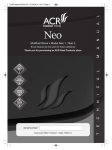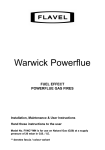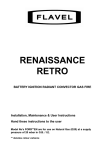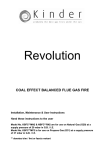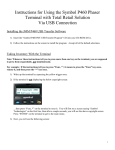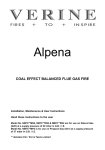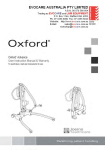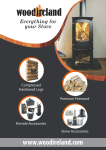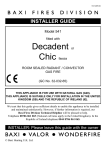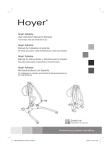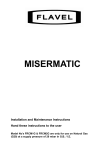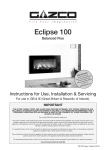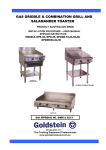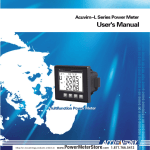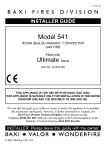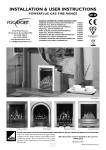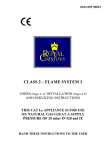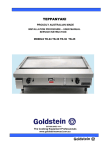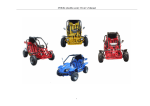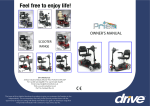Download Eden HE - Flames
Transcript
Eden HE HIGH EFFICIENCY BALANCED FLUE INSET ROOM HEATER Installation, Maintenance & User Instructions Hand these instructions to the user Model No’s BBFG**RN is for use on Natural Gas (G20) at a supply pressure of 20 mbar in G.B. / I.E. Model No’s BBFG**RP is for use on Propane Gas (G31) at a supply pressure of 37 mbar in G.B. / I.E. ** Denotes trim & colour variant CONTENTS Section 1 Information and Requirements PAGE 1.0 1.1 1.2 1.3 1.4 1.5 Appliance information Conditions of installation Flue terminal position Shelf position Hearths Efficiency Declaration 3 4 5 6 6 6 2.1 2.2 2.3 2.4 2.5 2.6 2.7 2.8 2.9 2.10 2.11 2.12 2.13 2.14 2.15 2.16 Unpacking the combustion chamber Preparing the combustion chamber opening (In studded wall) Preparing the combustion chamber opening (In chimney breast) Securing the fire to the opening Installation of the gas supply Specifying the flue system & components Preparation of the wall Preparation of the flue hole Fitting the starter pipe Fitting the flue pipes together Fitting the flue terminal Fitting the flue terminal guard Making the electrical connection Removal & re-fitting of the glass panel Removing the burner assembly Finishing the product aperture 7 8 9-10 11 12 13-15 15 16-17 15-16 18 19 20 21 22-23 24-26 27 3.1A 3.1B 3.2 3.3 3.4 Fitting the fuel bed logset Fitting the fuel bed pebbles set Lighting the appliance Removal / re-fitting of the restrictor baffle Fitting the handset wall bracket 28-32 33 34-38 39 39 4.1 4.2 4.3 4.4 4.5 4.6 Removal Removal Removal Removal Removal Removal 40 40-41 41 41 41 42 Section 2 Section 3 Section 4 Section 5 5.1 5.2 5.3 5.4 5.5A 5.5B Installation of Fire Assembling Fuel Bed and Commissioning Maintenance of the burner assembly of the gas control valve of the ultrasonic reciever of the pilot assembly / Replacement of the convection fan / thermal switch / Replacement of the handset battery User Instructions Installation Information / about the Eden HE BF Lighting the appliance Important safety information Cleaning & removing / replacing the glass panel Removal & re-fitting the fuel-bed logset Removal & re-fitting the pebble fuel-bed pebble set Model numbers BBFG**RN & BBFG**RP are manufactured by:- BFM Europe Ltd. Trentham Lakes, Stoke-on-Trent, Staffordshire, ST4 4TJ 2 43-44 45-48 49 41-43 53-57 58 1.0 SECTION 1 INFORMATION AND REQUIREMENTS APPLIANCE INFORMATION Main injector : (1 off) Stereomatic Cat 82 – size 2.00 (NG) Stereomatic Cat 82 – size 1.31 (LPG) Pilot Type : Max. Gross Heat Input : Min. Gross Heat Input : Cold Inlet Pressure : Ignition : Electrode Spark Gap : Packed Weight Combustion Chamber Packed Weight Flue Terminal Pack Supply Voltage : Supply Frequency : Supply Fuse : Electrical Supply Required Fig. 1 NG - Polidoro G27.2 LPG - Polidoro G24.1 6.3 kW 2.0 kW G20 G31 Integral to gas valve 4.0mm : 76.0 kg (Pack 1 of 2) : 16.0 kg (Pack 2 of 2) 230V a.c. 50Hz 3 Amp to BS 1362 230v AC, 50Hz Fig. 2 Top View of Combustion Chamber Side View of Combustion Chamber 111mm 795mm 370 mm 20.0+/-1.0 mbar (8.0 +/- 0.4 in w.g.) 37.0+/-1.0 mbar (14.8 +/- 0.4 in w.g.) 25mm 595mm 125mm 870mm 175mm 3 370mm 540mm INSTALLATION REQUIREMENTS 1.1 CONDITIONS OF INSTALLATION It is the law that all gas appliances are installed only by a GAS SAFE Registered Installer, in accordance with these installation instructions and the Gas Safety (Installation and Use) Regulations 1998 as amended. Failure to install appliances correctly could lead to prosecution. It is in your own interest and that of safety to comply with the law. The installation must also be in accordance with all relevant parts of the Local and National Building Regulations where appropriate, the Building Regulations (Scotland Consolidation) issued by the Scottish Development Department, and all applicable requirements of the following British Standard Code of Practice. 1. B.S. 5871 Part 1 Installation of Gas Fires 2. B.S. 6891 Installation of Gas Pipework 3. B.S. 5440 Parts 1 & 2 Installation of Flues and Ventilation 4. I.S 813 : 1996 Domestic Gas Installation, issued by the National Standards Authority of Ireland. 4 1.2 FLUE TERMINAL POSITION The minimum acceptable dimensions from the flue terminal to obstructions and ventilation openings are shown below and listed in the table It is important that the position of the flue allows the free passage of air across it at all times. The minimum acceptable space from the flue terminal to obstructions and ventilation openings are specified below (Fig. 3) Fig. 3 DIMENSION TERMINAL POSITION A B C D E F G H I J K L M N O P Q Directly below an opening, air brick, opening window Above an opening, air brick, opening window Horizontally to an opening, air brick, opening window etc. Below gutters, soil pipes or drain pipes Below eaves Below balconies or car port roof From a vertical drain pipe or soil pipe From an internal or external corner Above ground roof or balcony level From a surface facing the terminal From a terminal facing the terminal From an opening in the car port Vertically from a terminal on the same wall Horizontally from a terminal on the same Wall NOT APPLICABLE NOT APPLICABLE NOT APPLICABLE 5 MINIMUM DIMENSION 300mm (12in) 300mm (12in) 300mm (12in) 300mm (12in) 600mm (12in) 300mm (12in) 600mm (24in) 300mm (12in) 600mm (24in) 600mm (24in) 1200m (48in) 1500mm(59in) 300mm (12in) N/A N/A N/A 1.3 SHELF POSITION 1.4 HEARTHS 1.5 APPLIANCE EFFICIENCY DECLARATION The fire may be fitted below a combustible shelf providing there is a minimum distance of 300mm above the top of the fire and the shelf does not project more than 150mm. If the shelf overhangs more than 150mm the distance between the fire and the shelf must be increased by 15mm for every 25mm of additional overhang over 150mm. This appliance does not require the fitting of a hearth that projects in front of it when installed into a recess in either an existing chimney breast or a studded wall, providing the appliance is installed a minimum of 225mm above the floor level. The appliance must however stand on a non-combustible base that is a minimum thickness of 12mm The efficiency of this appliance has been measured as specified in BS EN 613 : 2001 and the result is 76% on both Natural Gas & LPG. The gross calorific value of the fuel has been used for this efficiency calculation. The test data from which it has been calculated has been certified by the British Standards Institute (BSI) Testing Services. The efficiency value may be used in the UK Government’s Standard Assessment Procedure (SAP) for energy rating of dwellings. 6 2.1 SECTION 2 INSTALLATION OF FIRE UNPACKING THE COMBUSTION CHAMBER Carefully lift the combustion chamber out of the carton. Remove the loose item packaging carefully from the pack. Check the contents as listed :- DO NOT UNDER ANY CIRCUMSTANCES USE THIS APPLIANCE IF THE GLASS PANEL IS BROKEN OR NOT SECURELY FIXED TO THE FIREBOX. Packing Check List Pack 1 of 2 - Combustion Chamber Pack 1 1 1 1 1 1 off off off off off off Combustion Chamber & Glass Assembly Boxed ceramic fuel-bed set (packed inside combustion chamber) Installation instruction / user manual Plastering frame Thermostatic remote handset Loose items pack – containing :4 off No. 12 x 40mm Screws 4 off Rawlplugs 1 off Efficiency Baffle 1 off Glass clamp 1 off Handset bracket 6 off M6 wingnuts 1 off Grommet 1 off PP3 9V Battery 1 off Flue gasket Pack 2 of 2 - Flue System Pack 1 1 1 1 3 off off off off off Flue Terminal 150mm Starter Pipe *Telescopic Flue Pipe - supplied in two seperate sections 90 degree elbow Pipe Clips *These two sections of the telescopic need to be assembled by the installer to form the 250mm to 410mm telescopic piece. PLEASE NOTE : Due to the high level of heat produced by this product we recommend that Plasma / LCD televisions are not placed in close proximity to this product. 7 2.2 PREPARATION OF THE COMBUSTION CHAMBER OPENING (INTO STUDDED WALL) All combustible parts of the studwork must be set at the distances as shown below in Fig. 4 & 5. Fig. 4 Minimum 50mm at rear Minimum 50mm at sides Studwork Combustion Chamber Fig. 5 Dim “A” Dim “B” Dim “C” MINIMUM HEIGHT FROM FLOOR LEVEL TO BOTTOM OF OPENING IS 225MM PLEASE NOTE : For the front face of the studwork a non combustible board such as “Versa Tecbor” should be used in a double 12mm thickness. “Versa Tecbor” board is available from Euroform Products Ltd, Tel : (01925) 860999, www.euroform.co.uk 8 Dimension “A” Opening Width = 835mm Dimension “B” Opening Height = 555mm Dimension “C” Minimum Depth 420mm 2.3 PREPARATION OF THE COMBUSTION CHAMBER OPENING (INTO EXISTING CHIMNEY BREAST) An opening should be constructed to the following dimensions in the existing chimney breast. See fig. 6 below Fig. 6 Width = 835mm Height = 545mm Lintle must project 150mm either side of the opening if cutting into an existing chimney breast Depth = 370mm PLEASE NOTE : The opening size as detailed above will require reducing in size to the product aperture and finishing in a high temperature plaster finish as detailed in section 2.8 NOTE : Please ensure that suitable cut outs in the sides and front face of the chimney breast are implemented for fixing of the flue pipe, and for future servicing. 9 Fig. 7 The Interactive Zone Openings, beams or joists within this area need to be assessed. 400mm interactive area Load triangle - No beam or opening permissible within this area 600mm load triangle Lintel e.g. 750mm x 75mm Proposed Opening in Chimney Breast The opening needs to be sufficient to accomodate the combustion chamber. To support the wall above the opening, a suitable lintel must be inserted across the top of the opening. The lintel could be either pre-cast concrete or steel - Catnic CN52 or CN 46 could be used, depending upon the inner wall thickness. Before proceeding with the installation of the fire, an assessment of the area immediately above the fire is required, see Fig. 7 above. If there is no existing openings within either triangle, proceed with forming the opening. However, if opening or beams occur within either triangle, then you should seek specialist advice from a structural engineer or consider relocating the proposed position of the firebox. 10 2.4 SECURING THE COMBUSTION CHAMBER TO THE OPENING a) Fig. 8 The combustion chamber must be secured to the opening via the four off screw and rawlplugs provided. Fig. 8 below shows the hole centres in the mounting flanges of the combustion chamber. 346mm CRS 4 holes in combustion chamber mounting flange for securing to the opening 858mm CRS b) Fig. 9 150mm 90mm DO NOT SECURE THE COMBUSTION CHAMBER INTO THE OPENING AT THIS POINT AS ACCESS WILL STILL BE REQUIRED TO RUN THE GAS SUPPLY PIPEWORK AS DETAILED IN SECTION 2.5 858mm CRS 346 CRS 11 2.5 INSTALLATION OF THE GAS SUPPLY (INTO STUDDED WALL OR EXISTING CHIMNEY BREAST) Before installing the combustion chamber, decide from which side or if a rear connection to the gas supply is required. Plan the pipe run to enter from the rear or below the firebox from the left, right or rear and connect to the inlet elbow. See Fig. 10, 11 & 12 below. The gas connection is located at the front right hand side of the fire. Note : Before breaking into the gas supply a gas tightness test should be carried out to establish that the existing pipework is sound. Fig. 10 Outer Cavity Wall or rear face of studwork Gas Supply entering from L/H/S Ensure if bringing gas supply through side or rear of a chimney breast that the pipe is sleeved and sealed with a suitable flexible, non setting compound Combustion Chamber Gas Supply entering from Rear of Combustion Chamber Fig. 11 Fig. 12 Combustion Chamber Combustion Chamber 12 Gas Supply entering from R/H/S 2.6 SPECIFYING THE FLUE SYSTEM & ASSOCIATED COMPONENTS 1 1 1 1 1 Flue Terminal Flue Terminal Guard 150mm Starter Pipe 250mm Minimum to 410mm Maximum Telescopic Flue Pipe 90 degree elbow 3 off Pipe clips This product requires a minimum vertical flue length of 150mm (6 inch). The horizontal length can then be extended up to a maximum of 1600mm, giving a total depth from mounting flange to outer wall of 2000mm. The standard flue kit supplied with the product comprises the following components :off off off off off This kit comprises the components required to fit the appliance into a studded wall or a chimney breast with a maximum depth of 880mm (from mounting flange of combustion chamber to outer face of wall) The main flue pipe section is a telescopic item which allows for a variation in depth of 160mm minimum to maximum length (250mm to 410mm). See Fig. 13 below. Telescopic Flue Section Fig. 13 90 Degree Elbow 150mm Starter Pipe Minimum Wall Thickness Excluding Flue Terminal 320mm Flue Terminal Length 200mm Telescopic Flue Section 90 Degree Elbow 150mm Starter Pipe Maximum Wall Thickness Excluding Flue Terminal 410mm Flue Terminal Length 200mm 13 In instances where a large depth cavity wall, chimney breast is encountered, or if the installation requires a flue termination to the left or right hand of the combustion chamber, the overall length from the centre of the flue spigot can be increased up to 1360mm as shown below in Fig. 14. This is only applicable to Natural Gas models, LPG models can only be fitted with the standard length flue duct. Fig. 14 1360mm Maximum 1360mm Maximum 1485mm Maximum 1605mm Maximum Combustion Chamber In installation’s where components are required that exceed the limitations of the components supplied with the standard kit, extra lengths of flue pipe are available from BFM Europe Ltd. The lengths available and part no’s are shown below. B-83970 B-83980 B-83990 B-84000 1000mm Flue Length Section 500mm Flue Length Section 250mm Flue Length Section 150mm Flue Length Section Always ensure that the solid section is fitted to the elbow when installing extra sections, followed by the telescopic section as supplied in the standard flue kit, this will allow adjustment for differences in cavity wall depth. See Fig. 15 overpage 14 Fig. 15 90 degree elbow 150mm starter pipe with standard flue length, 2 x 150mm with extended flue length Combustion Chamber 2.7 Additional Flue Length e.g. 1000mm to be fitted onto elbow before telescopic section is fitted, to take into account variation in wall cavity depths 250mm to 410mm Telescopic Section Flue Terminal PREPARATION OF THE WALL / MOUNTING The appliance and flue pipes must be installed at right angles to the mounting wall. The appliance itself should be installed vertically against a flat wall. Where an uneven wall surface is found, appropriate action should be taken to ensure that the appliance is not stressed or does not distort when installed. Ensure that the floor surface onto which the appliance is mounted onto is flat. The minimum height from the mounting base to the centre of the flue is shown on below in Fig. 16. NOTE : Adjustable feet are fitted to the combustion chamber to allow fine tuning of it’s positioning. A minimum clearance of 100mm is required above the top of the flue pipe to combustible surfaces Fig. 16 840mm to CRS of Flue Pipe with standard ducts, 990mm with extended flue lengths 90 degree elbow 300mm, 450mm if fitting with extended flue length 150mm Starter Pipe - additional 150mm pipe length (part no. B84000) to be fitted if used with extended horizontal flue. 15 2.8 a) b) c) PREPARATION OF THE FLUE HOLE Mark the position of the centre of the flue on the inner wall. (See Fig. 16 on previous page for position). Cut hole for outer flue pipe. There are two possible methods to achieve this, either core drill or via hammer and chisel. To core drill, proceed as follows :- Drill a pilot hole through the wall, in position as specified in figure 16 on previous page. Using a 6” core drill, drill the flue hole. To Hammer and chisel, proceed as follows :- Mark the position of the centre of the flue pipe as specified in figure 16. Mark the position of the hole around this point. Chisel out the area as marked on the wall. We then recommend that a cardboard cylinder is placed around the flue pipe and inserted in the chiselled out hole whilst making good. NOTE :- If the appliance is to be installed into a building under construction, it is recommended that a non-corrosive metal tube of 6” diameter be inserted into the position of the hole as specified on page 16. 2.9 a) Fig. 17 FITTING THE STARTER PIPE TO THE APPLIANCE Place gasket on top of the combustion chamber as shown below in Fig. 17 16 b) Fig. 18 c) Fig. 19 d) The starter pipe is attached to the appliance by placing it over the spigot on the combustion chamber and locating the mounting flange over the weld studs that protrude from the top panel on the combustion chamber. (See Fig. 18 below) When the starter pipe is located, tighten the 6 off wingnuts (supplied in loose items pack) to seal the starter pipe to the combustion chamber. (See Fig. 19 below) Fit the 90 degree elbow in the required direction of the flue pipe (L/H, R/H or to the rear), and secure to the starter pipe with the clamps as shown in section 2.9. 17 2.10 FITTING THE FLUE PIPES TOGETHER b) The clamps are fitted together as shown below in Fig. 20 & 21 a) Fig. 20 The flue pipes are located by pushing the sections together and clamping using the clamps provided. As with all balanced flue appliances ensure that the flue sections are fitted together horizontally. Fig. 21 18 2.11 FITTING THE FLUE TERMINAL a) Fig. 22 The flue terminal locates over the telescopic flue section and is clamped as per the other flue sections. The flue terminal must not protrude out of the wall further than 150mm. This is indicated by the ridge on the terminal itself. Failure to comply with this request will result in poor performance of the product during adverse weather conditions. See fig. 22 below for correct positioning of the flue terminal. Inner Cavity Wall Outer Cavity Wall Inner Cavity Wall Ensure flue pipes are sealed to inner and outer cavity and gap around terminal are sealed Outer Cavity Wall Flue terminal shown in correct position with inlet area flush with external wall Flue terminal shown in an incorrect position, protruding beyond the external wall Correct Position of Flue Terminal In-Correct Position of Flue Terminal 19 2.12 FITTING THE TERMINAL GUARD With the flue terminal in position, place the terminal guard over the top of the flue terminal and mark the position of the holes on the outer wall. Remove the terminal guard and drill the 4 off 6 mm holes. Insert the raw plugs into the drilled holes, replace the terminal guard over the top of the flue terminal and attach to the wall using the No.12 x 40mm screws provided with the terminal guard. See Fig. 23 below. Fig. 23 NOTE : In England & Wales, the building regulations require that a terminal guard should be fitted if the terminal could come into contact with people near the building or be subject to damage. BFM Europe Ltd. also recommend the fitting of a flue terminal guard where regulations do not demand that it be fitted. A suitable flue terminal guard is supplied with the appliance. 20 2.13 MAKING THE ELECTRICAL CONNECTION. WARNING : THIS APPLIANCE MUST BE EARTHED AND SHOULD BE PREFERABLY CONNECTED VIA A 3 AMP FIXED FUSED SPUR WITH A MINIMUM CONTACT SEPARATION OF 3MM. a) b) IT MAY HOWEVER BE CONNECTED TO A 3 PIN PLUG TO BS 5733, THAT IS FITTED WITH A 3 AMP FUSE TO BS 1362. The product is supplied with a mains cable and 3 pin plug fitted. The mains cable will exit the combustion chamber from the rear left hand side (viewed from the front), through the grommet. Plug the mains cable supplied into a suitable socket in close proximity to the appliance or remove the plug and wire into a fixed fused spur. 21 2.14 a) Fig. 24 b) Fig. 25 REMOVING / RE-FITTING THE GLASS PANEL To remove the glass frame, the glass clamp as supplied in the loose items pack will be required. Secure the clamp to the glass panel as shown below in Fig. 24 Remove the front grill by removing the 2 off retaining screws from the upturned tabs, 1 off at each end of the trim Remove the side trims by simply lifting clear (they are retained by magnets). See Fig. 25 below. Remove the front grill retaining screws at L/H and R/H sides NOTE : Always ensure that a consistent seal between the combustion chamber and the glass frame is achieved when replacing the glass panel. 22 c) Fig. 26 Remove the 5 off securing screws and glass panel retaining bracket that are located on the top underside face of the combustion chamber. behind the canopy. See Fig. 26 below. Glass Panel Retaining Bracket, secured by 5 off screws Combustion Chamber Glass panel c) Fig. 27 Lift the glass panel vertically to release from the bottom retaining channel and then tilt forwards as shown below in Fig. 27 / 28 to release. Fig. 28 Glass panel Glass panel Glass Clamp Bottom Glass Retaining Channel Glass Clamp Tilt Forwards Bottom Edge 23 2.15 a) Fig. 29 b) Fig. 30 REMOVING THE BURNER ASSEMBLY Lift the burner tray cover vertically clear as shown below in Fig. 29 and store in a safe place. This will allow access to the 6 off burner retaining screws, 3 off at the front of the burner and 3 off at the rear as shown below in Fig. 30 3 off Burner Retaining Screws at Rear 3 off Burner Retaining Screws at Front 24 c) Fig. 31 With the 6 off burner screws removed, remove the isolation switch from it’s retaining bracket at the front right hand side. This is achieved by lifting the switch clear from the bracket as shown below in Fig. 31 Lift switch from retaining bracket d) Fig. 32 Disconnect the burner gas supply pipe from the inlet elbow at the front right hand side by unscrewing the nut as shown below in Fig. 32 Disconnect the burner gas supply pipe 25 e) Fig. 33 f) g) h) i) j) k) l) m) The burner can then be lifted, tilted forwards and removed from the combustion chamber as shown below in Fig. 33 Make the gas connection to the inlet elbow as prepared in section 2.5 Before making the final gas connection, thoroughly purge the gas supply pipework to remove all foreign matter, otherwise serious damage may be caused to the gas control valve on the fire. Failure to purge the gas supply will invalidate the guarantee. Replace the burner unit in reverse order and re-connect the gas supply pipe. Replace the isolation switch into it’s retaining bracket in reverse order, taking care not to damage the wiring. Remove the pressure test point screw from the inlet elbow and fit a manometer. Turn on the main gas supply and carry out a gas tightness test. Turn on the electrical supply to the appliance via the fixed fused spur or plug. Finish the surface covering below the opening as shown in section 2.16 Fit the ceramics as shown in section 3.1A/B, replace the burner tray cover, glass panel and glass panel securing bracket / 5 off screws. Replace the side trims which are retained by magnets and the front grill, then proceed to section 3.2 (lighting the appliance). 26 2.16 a) Fig. 34 Plaster Frame meshing 300mm b) c) FINISHING OF THE PRODUCT APERTURE / FITTING THE PLASTERING FRAME The area below around the appliance will require a high temperature plaster finish around the appliance due to the high heat output level of the product, see Fig. 34 A plastering frame is supplied with the product to assist in obtaining this finished surface. To prevent plaster cracking and discolouration, finish the 600mm area above and the 300mm area at the side and below with a high temperature plaster finish as follows :Secure plaster frame via product fixing holes 600mm Completed opening with product installed - 310mm (H) x 790mm (W) 300mm 300mm The high temperature plaster should be applied over a heat proof screed to the manufacturers instructions (see below for manufacturers contact details) and left to dry for a minimum of 3 days. Supplier’s contact details for heat proof screed & plaster are as follows :Vitcas Ltd. 8 Bonville Road Brislington Bristol BS4 5NZ Tel : 0117 911 7895 www.vitcas.com [email protected] or 27 The Greener Company The Old Canteen Rosemount Works Huddersfield Road Elland HX5 0EE Tel : 01925 750290 www.thegreenercompany.com SECTION 3 INSTALLATION OF FIRE 3.1 A FITTING THE FUEL-BED LOGSET a) The vermiculite material should then be first layed around the burner tray as shown below in Fig. 35, resulting in an even layer. IF FITTING THE PRODUCT WITH THE PEBBLE FUELBED, PLEASE PROCEED TO SECTION 3.1B Fig. 35 b) Fig. 36 Place Log “1” at the left hand side of the burner tray fitting the holes in the bottom face of the log onto the 2 off location pegs as shown below in Fig. 36 Log No. 1 28 c) Fig. 37 d) Fig. 38 Place Log “2” at the right hand side centre of the burner tray fitting the hole in the bottom face of the log onto the single location peg as shown below in Fig. 37 Log No. 2 Place Log “3” at the right hand side of the burner tray fitting the hole in the bottom face of the log onto the single location peg as shown below in Fig. 38 Log No. 3 29 d) Fig. 39 Place Log “4” at the centre of the burner tray fitting the holes in the bottom face of the log onto the 2 off location pegs as shown below in Fig. 39 Log No. 4 e) Fig. 40 Place Log “5” at the right hand side of the burner tray locating in the groove of Log “3” as shown below in Fig. 40 Log No. 5 Groove in Log “3” for locating Log “5” 30 f) Fig. 41 Place Log “6” at the left hand side of the burner tray locating in the groove of Log “1” as shown below in Fig. 41 Log No. 6 Groove in Log “1” for locating Log “6” g) Fig. 42 Place Log “7” to the left hand centre side of the burner tray locating on the branch of Log “1” as shown below in Fig. 42 Log No. 7 Log “7” to rest on Log “1” branch as shown 31 h) Fig. 43 If required, fit the glow fibre material over the flame ports. To do this, seperate into short strands and place randomly over the flame porting area as shown below in Fig. 43. This material is only supplied to improve flame aesthetics and is optional to install. Place all over porting area of burner g) Refit the glass panel as described in section 2.14, then light the appliance as described as in section 3.2 IMPORTANT NOTE : PLEASE ENSURE THAT WHEN COMMISIONING THE FIRE THE FLAME PATTERN IS EVEN ACROSS THE WIDTH OF THE BURNER. IF AN UNEVEN FLAME PATTERN IS FOUND THEN RELAY THE QUANTITY VERMICULITE TO ACHEIVE AN EVEN FLAME PATTERN. Warning : Use only the logs supplied with the fire. When replacing the logs remove the old logs and discard them. Fit a complete set of logs of the correct type. Do not fit additional logs or any logs other than a genuine replacement set. This appliance does not contain any component manufactured from asbestos or asbestos related products. 32 3.1 B a) Fig. 44 b) Fig. 45 c) d) FITTING THE FUEL-BED PEBBLES Remove the log retaining brackets (which are held in place by self tapping screws) from the fuel-bed support plate and retain them in a safe place. Fold the log retaining bracket mounted to the burner to the flat position. Fit the pebbles to the burner tray as shown below in Fig. 44, do not fill the flame ports in the burner with pebbles. Fit the vermiculite material into the burner ports as shown below in Fig. 45. This material must be fitted in an even layer to ensure correct operation of the fire. Vermiculite to be placed over burner ports across length of burner as shown below If required, fit the glow fibre material over the flame ports. To do this, seperate into short strands and place randomly over the flame porting area as shown on previous page in Fig. 43. This material is only supplied to improve flame aesthetics and is optional to install. Refit the glass panel as described in section 2.14, then light the appliance as described as in section 3.2 33 3.2 LIGHTING THE APPLIANCE IMPORTANT : IF THE BURNER IS EXTINGUISHED FOR ANY REASON YOU MUST ENSURE THAT YOU WAIT A FULL FIVE MINUTES BEFORE ATTEMPTING TO RE-LIGHT THE FIRE. The BFM Fires Eden HE is controlled by the remote handset supplied with the fire. Ensure the 9V battery as supplied in the loose items pack has been fitted to the handset before attempting to light it. There are 3 modes of operation of the product, “MANUAL mode”, “TEMPERATURE mode” and “TIMER mode”. 3.2.1 a) Fig. 44 b) Fig. 45 Operation of the Fire in “MANUAL” mode Locate the ON/OFF switch on the appliance, it is situated at the right hand side in front of the glass panel. Ensure that the on / off switch on the valve is in the “ON” (1) position as shown below in Fig. 44 The remote handset is now used to control all functions of the fire. To light the fire, press the “UP” arrow and and “OFF” button simultateously. as shown on Fig. 45 below. You will hear a click and the fire begins a 30 second ignition process. The pilot and main burner will light. The appliance is now in “MANUAL mode” which will be shown via the “MAN” graphic on the display of the handset as shown below in Fig. 45 Manual Graphic on Handset Display 34 c) Fig. 46 With the product in “MANUAL” mode the fire can now be switched between HIGH rate heat input and LOW rate heat input by pressing the “DOWN” arrow on the handset. To reduce the flame height of the main burner incrementally, press the arrow momentarily. To reduce the heat input directly down to the minimum level, press the “SMALL” flame arrow on the handset twice, “LO” will be displayed. NOTE : The flame will go to HIGH rate heat input before going to designated LOW rate heat input. To return back to HIGH rate heat input press the “LARGE” flame button twice. To put the fire in In “STANDBY MODE” (only the pilot remains lit) press and hold the “SMALL” flame arrow on the handset. See figure 46 below. “LARGE” Flame / “UP” Arrow Button “SET” Button “SMALL” Flame / “DOWN” Arrow Button “OFF” Button d) To turn the fire off, press the “OFF” button, this will extinguish all flames including the pilot. 35 3.2.2 a) Operation of the Fire in “TEMPERATURE” mode In order to change the mode of operation from “MANUAL” to “TEMPERATURE”, press the “SET” button, the fire will then change to either “DAY TEMP” (Fig. 47) mode or “NIGHT TEMP” mode (Fig 48). To alternate between the 2, press the “SET” button. The display on the handset will show the current temperature in the room. Fig. 47 Fig. 48 “DAY TEMP” Mode “NIGHT TEMP” Mode b) c) d) e) NOTE : The “SET” button allows you to alternate between all modes of operation :- “ MANUAL”, “DAY TEMP”, “NIGHT TEMP”, “TIMER” and back to “MANUAL”. Alternatively, pressing either the “UP” or “DOWN” arrow allows the unit to revert to “MANUAL” mode. Within the “TEMPERATURE” mode there are options for either “DAY TEMP” or “NIGHT TEMP”. These temperatures can be set independently to allow a higher temperature to be maintained at night than during the day, or if setting the same temperature for day and night the fire will compensate for the generally cooler evening temperatures and automatically increase the heat input level accordingly. To set the temperature, ensure the handset is in “TEMPERATURE” mode and then press the “SET” button until the “TEMP” display flashes then let go. Proceed to set the desired temperature by pressing the “UP” (large flame) or “DOWN” (small flame) arrows as necessary, then press “OFF” to complete the process. NOTE : Minimum temperature is 5oC, Maximum temperature is 30oC, or minimum 41F to maximum 86F when in Fahrenheit mode. Press the “OFF” button to stop the display flashing or wait to return to “TEMPERATURE” mode. NOTE : If you set a temperature below the current room temperature the fire will switch to standby mode (pilot burner only) until the room has cooled to the temperature you have set on the handset display. If you would like the “NIGHT TEMP” to turn the fire off then decrease the temperature until [----] is displayed. 36 3.2.3 a) b) c) P1 with “Sun” symbol illuminated Operation of the Fire in “TIMER” mode In order to change the mode of operation from “MANUAL” to “TIMER”, press the “SET” button, the fire will then alternate between the settings until the “TIMER” mode is displayed. NOTE : The “SET” button allows you to alternate between all modes of operation :- “ MANUAL”, “DAY TEMP”, “NIGHT TEMP”, “TIMER” and back to “MANUAL”. Alternatively, pressing either the “UP” or “DOWN” arrow allows the unit to revert to “MANUAL” mode. Within the “TIMER” setting mode there are two programmable settings you can make over a 24 hour period, namely P1 and P2. To set the timer, ensure the handset is in “TIMER” mode as detailed in section a) above. To set the P1 timed start setting, press and hold the “SET” button until the P1 (sun symbol is displayed as per Fig. 39 below) and the time flashes. Set the hour by pressing the “UP” (large flame) and set the minutes (in ten minute increments) by pressing the “DOWN” (small flame) as necessary, then press “OFF” button to complete the process. Repeat for the P1 (moon symbol is displayed as per Fig. 50 below) Set the hour by pressing the “UP” (large flame) and set the minutes (in ten minute increments) by pressing the “DOWN” (small flame) as necessary, then press “OFF” button to complete the process. Fig. 50 Fig. 49 P1 with “Moon” symbol illuminated d) To set the P2 timed setting, press the “SET” button until the “TIMER” mode is displayed. Hold the “SET” button until the display flashes the current time for P1. Press the “SET” button again to scroll past the setting for P1 (sun) and P1 (moon). The time should now be flashing on the handset. Set the hour by pressing the “UP” (large flame) and set the minutes (in ten minute increments) by pressing the “DOWN” (small flame) as necessary, then press “OFF” button to complete the process. 37 3.2.4 a) b) 3.2.5 a) b) 3.2.6 a) Low Battery Signal When the battery in the handset needs replacing, “BATT” will be displayed on the handset. Remove the cover on the rear of the handset and replace the 9V battery as necessary. To Set the Time on the Remote Handset Simultanelously press the “UP” (large flame) arrow and “DOWN” (small flame) arrow buttons on the remote handset. Press the “UP” (large flame) arrow to set the hour and the “DOWN” (small flame) arrow to set the minutes. To Set the oC / 24 Hour or oF / 12 Hour Clock Press and hold the “OFF” and the “DOWN” (small flame) arrow buttons on the handset simultaneously until the display changes from oC to oF and vice versa 38 3.4 a) b) Fig. 51 REMOVAL / RE-FITTING OF THE RESTRICTOR BAFFLE Remove the glass panel as shown in section 2.14 The restrictor baffle is fitted to the inner roof of the combustion chamber and is secured by the screw as shown below in Fig. 51 Restrictor baffle secured by 1 off screw into roof of combustion chamber c) THE RESTRICTOR BAFFLE SHOULD ONLY BE FITTED WITH STANDARD FLUE DUCT LENGTHS (UP TO 350MM FROM BACK OF FIRE TO OUTER WALL) AND MUST NOT BE USED WITH EXTENDED FLUE DUCTS. 3.5 FITTING THE HANDSET WALL BRACKET b) If fitting the wall bracket, please be advised that the thermostatic sensor is contained within the handset itself, so the position of the wall bracket will therefore be the position of temperature measurement within the room. To fit, position as necessary, mark hole positions, drill and secure with fixings provided. a) The wall bracket is supplied in the loose items pack and is optional to fit. 39 Servicing Notes SECTION 4 MAINTENANCE Servicing should be carried out annually by a competent person such as a GAS SAFE registered engineer. It is a condition of BFM Fires lifetime guarantee scheme that this is carried out by a competent person in accordance with these servicing notes, and must include a pilot change. The condition of the logs should be checked and if necessary the whole set should be replaced with a genuine replacement set. After any servicing work a gas tightness check must always be carried out. BEFORE ANY SERVICING WORK IS CARRIED OUT ENSURE THE PRODUCT HAS BEEN DISCONNECTED FROM THE ELECTRICITY SUPPLY. 4.1 Removing the burner assembly from the fire. 4.1.1 Attach the glass panel clamp as shown in section 2.14 4.1.3 Remove the glass panel retaining bracket by removing the 5 off retaining screws as shown in section 2.14 4.1.2 4.1.4 4.1.5 4.1.6 Remove the side trims and base trim as shown in section 2.14 Remove the glass panel as shown in section 2.14 Remove the logs and vermiculite from the burner tray. Remove the burner tray cover by lifting clear. 4.1.7 Remove the burner retaining screws as shown in section 2.15 4.1.9 Isolate the gas supply at the inlet elbow then disconnect the burner inlet pipe as shown in section 2.15 4.1.8 4.1.10 4.2 4.2.1 4.2.2 Remove the on/off switch from it’s retaining bracket on the right hand side as shown in section 2.15 Lift the burner and tilt forwards from the combustion chamber to remove, as shown in section 2.15 Removing the gas control valve from the fire. Remove the burner from the combustion chamber as described in section 4.1 above. Disconnect the inlet, outlet, pilot pipes and thermocouple connection from the control valve. 40 4.2.3 Replace in reverse order and carry out a gas test 4.3 Removing the ultrasonic receiver. 4.3.2 Disconnect the control wires from the receiver. 4.3.1 4.3.3 4.3.4 4.3.5 4.4 4.4.1 4.4.2 4.4.3 4.4.4 4.5 4.5.1 4.5.2 4.5.3 4.5.4 4.5.5 4.5.6 4.5.7 Remove the burner from the combustion chamber as described in section 4.1. Disconnect the ignition wire. Re-fit the new receiver and re-fit the control wires to the control valve. Re-assemble the burner unit to the combustion chamber and carry out a gas tightness test. Removing the pilot assembly Remove the burner from the combustion chamber as described in section 4.1. Disconnect the pilot supply pipe, ignition wire and thermocouple connection to the gas contol valve. Remove the pilot retaining screws and lift the pilot assembly clear Re-assemble in reverse order and carry out a gas tightness test. Removing the convection fan / thermal switch Remove the burner from the combustion chamber as described in section 4.1. Ensure that the electrical supply to the fire is isolated. Disconnect the wiring to the motor on the convection fan Remove the retaining screws that hold the convection fan assembly to the base of the combustion chamber. Disconnect the thermal switch wires. Lift the convection fan assembly clear if required. Re-assemble in reverse order. 41 4.6 4.6.1 Replacing the Batteries in the Handset Remove and re-fit the new 9V battery by removing the cover on the back of the handset. Parts Shortlist Gas control valve Receiver unit Thermostatic handset NG Pilot LPG Pilot Convection fan assembly Convection fan thermostat Glass panel Complete log set Log 1 only Log 2 only Log 3 only Log 4 only Log 5 only Log 6 only Log 7 only Embaglow Pebble set Vermiculite B-92200 B-153140 B-148120 CV-104530 CV-104627 B-128120 B-128130 B-128210 B-128240 B-128250 B-128260 B-128270 B-128280 B-128290 B-128300 B-128310 B-120070 B-128320 CV-107116 42 5.1 SECTION FIVE - USER INSTRUCTIONS INSTALLATION INFORMATION CONDITIONS OF INSTALLATION It is the law that all gas appliances are installed only by a competent (e.g. Registered) Installer, in accordance with the installation instructions and the Gas Safety (Installation and Use) Regulations 1998. Failure to install appliances correctly could lead to prosecution. It is in your own interest and that of safety to comply with the law. The fire may be fitted below a combustible shelf provided that the shelf is at least 200mm above the top of the appliance and the depth of the shelf does not exceed 150mm. The fire may be installed below combustible shelves which exceed 150mm deep providing that the clearance above the fire is increased by 15mm for each 25mm of additional overhang in excess of 150mm. If this appliance is fitted directly on to a wall without the use of a fireplace or surround, soft wall coverings such as wallpaper, blown vinyl etc. could be affected by the heat and hot convection air and may discolour or scorch. This should be considered when installing or decorating. The Model number of this appliance is as stated on the rating plate affixed to the control panel of the fire and the appliance is manufactured by:- BFM Europe Ltd Trentham Lakes Stoke on Trent ST4 4TJ 43 ABOUT YOUR NEW EDEN HE BF (High Efficiency) GAS FIRE The BFM Fires Eden High Efficiency log / pebble effect gas fire incorporates a unique and highly developed fuel bed which gives the realism of a loose log layout combined with realistic flames and glow. The fire has a thermostatically controlled convection air fan to increase the efficiency of the product. The convection fan only operates when the fire is up to temperature and therefore may take 20 to 30 minutes to come on when the fire is operated from cold. The use of durable ceramic material in the construction of the fuelbed components ensures long and trouble free operation. When first using the new fire a slight smell may be noticed. This is due to starch used in the manufacture of the soft ceramic coals, it is non-toxic and will soon disappear. Please take the time to fully read these instructions as you will then be able to obtain the most effective and safe operation of your fire. IMPORTANT SAFETY INFORMATION WARNING This appliance has a naked flame and as with all heating appliances a fireguard should be used for the protection of children, the elderly and infirm. Fireguards should conform to B.S. 8423 : 2002 (Fireguards for use with gas heating appliances). It is important that this appliance is serviced at least once a year by a GAS SAFE registered engineer. During the annual service, replacement of the pilot must be carried out. This is a condition of the manufacturers guarantee. Rubbish of any type must NEVER be thrown onto the fuel bed, this could affect safe operation and damage the fire. Any debris or deposits should be removed from the fuel bed from time to time. This may be carried out by referring to the cleaning section as described later in this book. Only the correct number and type of logs must be used and only complete and genuine replacement sets must be used. Always keep furniture and combustible materials well clear of the fire and never dry clothing or items either on or near to the fire. Never use aerosols or flammable cleaning products near to the fire when it is in use. The ceramic fuel bed remains hot for a considerable period after use and sufficient time should be allowed for the fire to cool before cleaning etc. 44 5.2 LIGHTING THE APPLIANCE IMPORTANT : IF THE BURNER IS EXTINGUISHED FOR ANY REASON YOU MUST ENSURE THAT YOU WAIT A FULL FIVE MINUTES BEFORE ATTEMPTING TO RE-LIGHT THE FIRE. The BFM Fires Eden HE is controlled by the remote handset supplied with the fire. Ensure the 9V battery as supplied in the loose items pack has been fitted to the handset before attempting to light it. There are 3 modes of operation of the product, “MANUAL mode”, “TEMPERATURE mode” and “TIMER mode”. 5.2.1 a) Fig. 1 b) Fig. 2 Operation of the Fire in “MANUAL” mode Locate the ON/OFF switch on the appliance, it is situated at the right hand side in front of the glass panel. Ensure that the on / off switch on the valve is in the “ON” (1) position as shown below in Fig.1 The remote handset is now used to control all functions of the fire. To light the fire, press the “UP” arrow and and “OFF” button simultateously. as shown on Fig. 2 below. You will hear a click and the fire begins a 30 second ignition process. The pilot and main burner will light. The appliance is now in “MANUAL mode” which will be shown via the “MAN” graphic on the display of the handset as shown below in Fig. 2 Manual Graphic on Handset Display 45 c) Fig. 3 With the product in “MANUAL” mode the fire can now be switched between HIGH rate heat input and LOW rate heat input by pressing the “DOWN” arrow on the handset. To reduce the flame height of the main burner incrementally, press the arrow momentarily. To reduce the heat input directly down to the minimum level, press the “SMALL” flame arrow on the handset twice, “LO” will be displayed. NOTE : The flame will go to HIGH rate heat input before going to designated LOW rate heat input. To return back to HIGH rate heat input press the “LARGE” flame button twice. To put the fire in In “STANDBY MODE” (only the pilot remains lit) press and hold the “SMALL” flame arrow on the handset. See figure 3 below. “LARGE” Flame / “UP” Arrow Button “SET” Button “SMALL” Flame / “DOWN” Arrow Button “OFF” Button d) To turn the fire off, press the “OFF” button, this will extinguish all flames including the pilot. 46 5.2.2 a) Operation of the Fire in “TEMPERATURE” mode In order to change the mode of operation from “MANUAL” to “TEMPERATURE”, press the “SET” button, the fire will then change to either “DAY TEMP” (Fig. 4) mode or “NIGHT TEMP” mode (Fig 5). To alternate between the 2, press the “SET” button. The display on the handset will show the current temperature in the room. Fig. 5 Fig. 4 “DAY TEMP” Mode “NIGHT TEMP” Mode b) c) d) e) NOTE : The “SET” button allows you to alternate between all modes of operation :- “ MANUAL”, “DAY TEMP”, “NIGHT TEMP”, “TIMER” and back to “MANUAL”. Alternatively, pressing either the “UP” or “DOWN” arrow allows the unit to revert to “MANUAL” mode. Within the “TEMPERATURE” mode there are options for either “DAY TEMP” or “NIGHT TEMP”. These temperatures can be set independently to allow a higher temperature to be maintained at night than during the day, or if setting the same temperature for day and night the fire will compensate for the generally cooler evening temperatures and automatically increase the heat input level accordingly. To set the temperature, ensure the handset is in “TEMPERATURE” mode and then press the “SET” button until the “TEMP” display flashes then let go. Proceed to set the desired temperature by pressing the “UP” (large flame) or “DOWN” (small flame) arrows as necessary, then press “OFF” to complete the process. NOTE : Minimum temperature is 5oC, Maximum temperature is 30oC, or minimum 41F to maximum 86F when in Fahrenheit mode. Press the “OFF” button to stop the display flashing or wait to return to “TEMPERATURE” mode. NOTE : If you set a temperature below the current room temperature the fire will switch to standby mode (pilot burner only) until the room has cooled to the temperature you have set on the handset display. If you would like the “NIGHT TEMP” to turn the fire off then decrease the temperature until [----] is displayed. 47 5.2.3 a) b) c) P1 with “Sun” symbol illuminated Operation of the Fire in “TIMER” mode In order to change the mode of operation from “MANUAL” to “TIMER”, press the “SET” button, the fire will then alternate between the settings until the “TIMER” mode is displayed. NOTE : The “SET” button allows you to alternate between all modes of operation :- “ MANUAL”, “DAY TEMP”, “NIGHT TEMP”, “TIMER” and back to “MANUAL”. Alternatively, pressing either the “UP” or “DOWN” arrow allows the unit to revert to “MANUAL” mode. Within the “TIMER” setting mode there are two programmable settings you can make over a 24 hour period, namely P1 and P2. To set the timer, ensure the handset is in “TIMER” mode as detailed in section a) above. To set the P1 timed start setting, press and hold the “SET” button until the P1 (sun symbol is displayed as per Fig. 6 below) and the time flashes. Set the hour by pressing the “UP” (large flame) and set the minutes (in ten minute increments) by pressing the “DOWN” (small flame) as necessary, then press “OFF” button to complete the process. Repeat for the P1 (moon symbol is displayed as per Fig. 7 below) Set the hour by pressing the “UP” (large flame) and set the minutes (in ten minute increments) by pressing the “DOWN” (small flame) as necessary, then press “OFF” button to complete the process. Fig. 7 Fig. 6 P1 with “Moon” symbol illuminated d) To set the P2 timed setting, press the “SET” button until the “TIMER” mode is displayed. Hold the “SET” button until the display flashes the current time for P1. Press the “SET” button again to scroll past the setting for P1 (sun) and P1 (moon). The time should now be flashing on the handset. Set the hour by pressing the “UP” (large flame) and set the minutes (in ten minute increments) by pressing the “DOWN” (small flame) as necessary, then press “OFF” button to complete the process. 48 5.3 WARNING IMPORTANT SAFETY INFORMATION This appliance is not intended for use by persons (including children) with reduced physical, sensory or mental capabilities, or lack of experience and knowledge, unless they have been given supervision or instruction concerning use of the appliance by a person responsible for their safety. Children should be supervised to ensure that they do not play with the appliance. This appliance has a naked flame and as with all heating appliances a fireguard should be used for the protection of children, the elderly and infirm. Fireguards should conform to B.S. 8423 : 2002 (Fireguards for use with gas heating appliances). It is important that this appliance is serviced at least once a year by a GAS SAFE registered engineer THE FIRE MUST NOT BE OPERATED WITH THE GLASS CRACKED, BROKEN OR REMOVED. Any debris or deposits should be removed from the fuel bed from time to time. This may be carried out by referring to the cleaning section as described later in this book. Only the correct number and type of logs or pebbles must be used and only complete and genuine replacement sets must be used. Always keep furniture and combustible materials well clear of the fire and never dry clothing or items either on or near to the fire. Never use aerosols or flammable cleaning products near to the fire when it is in use. The ceramic fuel bed remains hot for a considerable period after use and sufficient time should be allowed for the fire to cool before cleaning etc. 49 5.4 CLEANING - WARNING Before attempting any cleaning operation ensure that the fire has been allowed to fully cool. CLEANING THE ENAMELLED METAL PARTS These enamelled parts should only be cleaned using a clean, damp cloth. The trim is best cleaned by removing it from the fire and placing it face up on a flat surface. Abrasive cleaners, chemical cleaning agents or any type of polish must never be used as damage to the finish may result. CLEANING THE FUEL BED We do not recommend cleaning of logs or fuelbed components as these are fragile and damage may result. None of these parts must be washed or exposed to any cleaning agents or water. Any damaged parts must be replaced by contacting your dealer or telephoning BFM Fires on the number stated on the rear cover of this book. Logs or pebbles must only be replaced with a complete and genuine replacement set and the fire must never be run with the wrong number or damaged logs or pebbles. The fuelbed must be carefully reassembled as stated in the following section. CLEANING THE GLASS PANEL To clean the glass panel, please remove it from the product as described overpage on pages 51-52. Use a clean damp cloth and ceramic glass cleaner to remove any stains or deposits from the glass panel. Do not using scouring pads as this may scratch the surface finish of the glass panel. PLEASE NOTE :- The glass will require cleaning periodically. Condensation produced by the products of combustion will create marks on the inside face of the glass panel. 50 CLEANING - REMOVING / REPLACING THE GLASS PANEL a) Fig. 8 b) Fig. 9 To remove the glass frame, the glass clamp as supplied in the loose items pack will be required. Secure the clamp to the glass panel as shown below in Fig. 8 Remove the front grill by removing the 2 off retaining screws from the upturned tabs, 1 off at each end of the trim Remove the side trims by simply lifting clear (they are retained by magnets). See Fig. 9 below. Remove the front grill retaining screws at L/H and R/H sides NOTE : Always ensure that a consistent seal between the combustion chamber and the glass frame is achieved when replacing the glass panel. 51 c) Fig. 10 Remove the 5 off securing screws and glass panel retaining bracket that are located on the top underside face of the combustion chamber. behind the canopy. See Fig. 10 below. Glass Panel Retaining Bracket, secured by 5 off screws Combustion Chamber Glass panel c) Fig. 11 Lift the glass panel vertically to release from the bottom retaining channel and then tilt forwards as shown below in Fig. 12 / 12 to release. Fig. 12 Glass panel Glass panel Glass Clamp Glass Clamp Tilt Forwards Bottom Edge Bottom Glass Retaining Channel 52 5.5 A REMOVAL AND REPLACING THE FUEL-BED LOGSET IF FITTING THE PRODUCT WITH THE PEBBLE FUELBED, PLEASE PROCEED TO SECTION 5.5B. Remove the glass panel as shown on pages 51-52 before attempting to remove or replace the logs. a) Fig. 13 b) Fig. 14 The vermiculite material should then be first layed around the burner tray as shown below in Fig. 13, resulting in an even layer. Place Log “1” at the left hand side of the burner tray fitting the holes in the bottom face of the log onto the 2 off location pegs as shown below in Fig. 14 Log No. 1 53 c) Fig. 15 Place Log “2” at the right hand side centre of the burner tray fitting the hole in the bottom face of the log onto the single location peg as shown below in Fig. 15 Log No. 2 d) Fig. 16 Place Log “3” at the right hand side of the burner tray fitting the hole in the bottom face of the log onto the single location peg as shown below in Fig. 16 Log No. 3 54 d) Fig. 17 Place Log “4” at the centre of the burner tray fitting the holes in the bottom face of the log onto the 2 off location pegs as shown below in Fig. 17 Log No. 4 e) Fig. 18 Place Log “5” at the right hand side of the burner tray locating in the groove of Log “3” as shown below in Fig. 18 Log No. 5 Groove in Log “3” for locating Log “5” 55 f) Fig. 19 Place Log “6” at the left hand side of the burner tray locating in the groove of Log “1” as shown below in Fig. 19 Log No. 6 Groove in Log “1” for locating Log “6” g) Fig. 20 Place Log “7” to the left hand centre side of the burner tray locating on the branch of Log “1” as shown below in Fig. 20 Log No. 7 Log “7” to rest on Log “1” branch as shown 56 h) Fig. 21 If required, fit the glow fibre material over the flame ports. To do this, seperate into short strands and place randomly over the flame porting area as shown below in Fig. 21. This material is only supplied to improve flame aesthetics and is optional to install. Place all over porting area of burner i) Refit the glass panel as described on pages 51-52, then light the appliance as described as in section 5.2 IMPORTANT NOTE : PLEASE ENSURE THAT WHEN COMMISIONING THE FIRE THE FLAME PATTERN IS EVEN ACROSS THE WIDTH OF THE BURNER. IF AN UNEVEN FLAME PATTERN IS FOUND THEN RELAY THE QUANTITY VERMICULITE TO ACHEIVE AN EVEN FLAME PATTERN. Warning : Use only the logs supplied with the fire. When replacing the logs remove the old logs and discard them. Fit a complete set of logs of the correct type. Do not fit additional logs or any logs other than a genuine replacement set. This appliance does not contain any component manufactured from asbestos or asbestos related products. 57 5.5 B REMOVAL & RE-FITTING THE FUEL-BED PEBBLES a) Fit the pebbles to the burner tray as shown below in Fig. 17, do not fill the flame ports in the burner with pebbles. Remove the glass panel as shown in on pages 51-52 before attempting to remove or replace the logs. Fig. 17 b) Fig. 18 c) Fit the vermiculite material into the burner ports as shown below in Fig. 18. This material must be fitted in an even layer to ensure correct operation of the fire. Vermiculite to be placed over burner ports across length of burner as shown below If required, fit the glow fibre material over the flame ports. To do this, seperate into short strands and place randomly over the flame porting area as shown on previous page in Fig. 17. This material is only supplied to improve flame aesthetics and is optional to install. 58 d) Refit the glass panel as described on pages 51-52, then light the appliance as described as in section 5.2 User Replaceable Parts Glass panel Complete log set Log 1 only Log 2 only Log 3 only Log 4 only Log 5 only Log 6 only Log 7 only Embaglow Pebble set Vermiculite B-128210 B-128240 B-128250 B-128260 B-128270 B-128280 B-128290 B-128300 B-128310 B-120070 B-128320 CV-107116 Due to our policy of continual improvement and development the exact accuracy of illustrations and descriptions contained in this book cannot be guaranteed Part No. B-137050 Issue 6 BFM Europe Ltd. Trentham Lakes Stoke-on-Trent Staffordshire ST4 4TJ www.bfm-europe.com Telephone - General Enquiries : Telephone - Service : (01782) 339000 (0844) 7700169



























































